A
| Aikey Brae stone circle or Parkhouse stone circle |
|---|

Elliptical Recumbent Stone Circle; Widest diameter 16.6 metres, narrowest diameter 12.8 metres five erect stones including recumbent and E pillar, five prostrate stones including W pillar. They are set upon a bank of small stones and earth 1.92m x 0.76m. c14.4 m in diameter, with kerbs formed by slab-like stones on the inner and outer faces, it appears flat, however below the surface, the interior is made up, at least partially, of a mass of small boulders. It was a considerable feat to haul all the great stones of the ring, including the massive, whale-like recumbent (weighing 21 tons), into position on this bank. Such banks are a particular feature of recumbent Stone circles in Buchan. |
| Anne Rochfords Gravestone - Tree of Life |

An inspired contemporary gravestone, by Helen Denerley, with a brass and copper relief appliqué in the form of the tree of life in a sinuous style. A mouse and a lizard are nestled among the tree's roots. More Information |
B
| Battle of Corrichie, Memorial |
|---|

A roughly cut granite menhir with an inscription cut in relief. The Gaelic inscription reads: "Cuimhnichibh La Coire Fraoichidh" or "Remember the day of Corrichie". The battlefield is now mainly covered by commercial forest. More Information |
| Brandsbutt stone |

A class I Pictish symbol stone that may re-use a megalith from the stone circle that once stood here. 3 feet 6 inches high by 4 feet 2 inches wide by about 3 feet thick. It is re-assembled from fragments found in a dyke and some missing parts are substituted with cement. The south-east face bears the crescent and V rod and serpent and z rod symbols to the left of the symbols is an ogam inscription which reads IRATADDOARENS some part of which may be a version of the name Ethernan (as in St.Ethernan). |
| Broomend of Crichie |

A class I Pictish Symbol stone located in the remains of a class II henge monument (a henge is defined by having a bank and ditch class II henges are those with two opposed entrances). The symbol stone was originally located on a bank 50 yards to the north-east and was moved when this bank was utilised as ballast during the construction of the adjacent railway line. It was probably a Pictish reuse of one of the megaliths that formed the avenue and the other stone circle mentioned below. It bears a 'Pictish Beast' symbol over a crescent and V rod. More Information |
C
| Candle Stone |
|---|
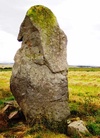
A large very phallic standing stone 3.1 m high located just below a low summit, on a slope which shelves gently to the SE. More Information |
| Changing environment |
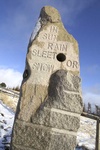
A large granite menhir inscribed "in sun rain sleet or snow" the quarry drill marks left as a feature. The sculpture contains a couple of monocular telescopic lenses that gives the viewer a close-up look of the surrounding countryside and Corgarff castle. More Information |
| Cothiemuir Stone Circle |

Also known as Devil's Hoofmarks, from some probable cup marks on the outer face of the recumbent The circle stones are of red granite. |
| Culblean Memorial |

A modern stone menhir with bronze plaque commemorating a 14th century battle. More Information |
| Cullerlie Stone Circle |

In a fairly low-lying location, this circle consists of 8 rough boulders set in a circle 10.1 m in diameter. The circle contains eight small cairns, that showed signs of cremations, in some of the cairns were found burnt bone, charcoal, flint tools and a fragment of pottery. More Information |
D
| Deer Park standing stones, or the Druids |
|---|

A setting of three stones, older reports describe a fourth fallen stone. Variously described as standing stones or the remains of a circle. It appears to have been too small to be a Recumbent Stone Circle. More Information |
E
| Easter Aquhorthies RSC |
|---|

An impressive recumbent stone circle, 19.5 m in diameter, consisting of nine erect stones, the recumbent, two flankers and, in addition, two massive blocks which form a reserved area in front of the recumbent The circle is located near the crest of a hill shoulder, at 175 m OD. The characteristic differentiation between the recumbent with its flankers and the other circle stones can be seen vividly, both in terms of height of stones and their geological origin. The stones are graded in height from the 2.25 m tall flankers to the 1.7 m high stones on the circumference opposite, and, while the nine circle stones are of rough pinkish porphyry or (in the case of the second stone to the east of the flanker) a glowing red jasper, the flankers are of grey granite and the recumbent of reddish granite from near Bennachie. The outer face of the 3.8 m long recumbent has been smoothed carefully. The circle stones are set in a low bank. The very slight rise in the interior and a 1934 reference to a cist suggest the existence of a later ring cairn, now extremely vestigial. Its almost perfectly circular plan places this circle early in the series of recumbent stone circles More Information |
G
| Gaval Stone |
|---|
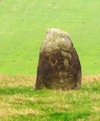
Remains of recumbent stone circle; one remaining stone, impossible to say whether in situ or has fallen and been re-erected. The area of the circle, complete until about 1844, may have extended to the E of the stone. Apart from the stone, there is no trace of the other remains of the circle. |
| George Duff memorial, Banff Castle |

A roughly cut small sandstone menhir with an inset bronze plaque and Rotary Club insignia. More Information |
| Gravnie Braes Stone Circle |

Remains of a stone circle; five stones altogether, two standing and three lying in an arc. Surrounded by a distinct stone mound which may be the result of ploughing. One stone has fallen since 1961. More Information |
I
| In the beginning, Tarland |
|---|

Sculpture using engraved granite one large and three smaller stones, that clearly references local precedents particularly from the neolithic and megalithic periods in both the style and decoration of the piece and, of course, the title. More Information |
K
| Kincardine ONeil War Memorial |
|---|

The Kincardine o'Neil war memorial stands on the main street in the village near the old church. It commemorates the dead of both World War I & II. It is a rough hewn standing stone onto which is carved a sword pointing downwards. This stone surmounts a rectangular base with inset plaques on the face. On either side are piled loose boulders. It was unveiled September 12th 1920. More Information |
| Kirkton of Bourtie Recumbent Stone Circle |

The remains of this recumbent stone circle are situated in a cultivated field and comprise the recumbent, the E flanker, and two stones on the W arc. All the stones are of granite, the recumbent measuring 5.1m in length by 1.9m in height and 1.7m in thickness. The E flanker measures 2.9m in height by 1.45m in breadth and 1m in thickness. A large void beneath the E end of the recumbent has been filled in antiquity with a large boulder. The erect stones on the WSW and WNW of the circle measure 1.7m and 2.2m in height respectively. RCAHMS |
L
| Loanhead of Daviot Recumbent-stone circle |
|---|

Recumbent stone circle containing a ring cairn with adjacent cremation cemetery. One of the stones, next to the flanker to the east of the recumbent, bears 12 cup marks. The stone circle precedes, in time, the cairn which covers cremations and the scattering of bone, flint and pottery. Excavation of the cairn showed use from the second to the first half of the first millenium B. C. . The adjacent Bronze Age cremation cemetry dates from circa 3500 years ago. At least 31 cremations and burials occured around a central pit, 8 of them children between 3 and 6. 11 deposits in urns have been found and 9 in pits some deposits containing several individuals. This place was used as a sacred site over an extended period of several thousands of years. More Information |
M
| Midmar Recumbent Stone Circle |
|---|

The kirk yard contains a recumbent stone circle; This is a landscaped and slightly re-arranged recumbent stone circle, 17.3m in diameter; it consists of the recumbent, two flankers and five others. The two flankers, each c2.5m high (matched and shaped into two enormous canine teeth), flank a massive recumbent 4.5 m long which weighs some 20 tons it has some markings on the top. The present church was built in 1797 when the old church near Midmar was pulled down . The old graveyard continued in use until 1914 when the new one was laid out around the stone circle. It is likely that the ring cairn was tidied away, probably when the graveyard was laid out around the circle in 1914. Very well maintained |
| Millennium Stone |
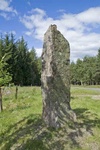
Dedicated on 1st January 2000 with nearly 300 people from local communities of Finzean, Ballogie and Birse in attendance. Anointed with waters from the boundary rivers of the community. The stone came from Craig of Woodend, near the Finzean quarry that was the source of the Birse War Memorial stones, stone donated by the Farquarsons of Finzean estate. More Information |
O
| Old Road, Bennachie Centre |
|---|
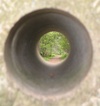
Carved words "THE TRAMPLING TO INVERURIE" and "THE TRUNDLING TO INSCH" on each side of a large granite stone next to the path just above the Bennachie Centre. In addition there is a hole drilled through the stone providing a sight line along the path. More Information |
P
| Picardy Stone, Myreton |
|---|

Class 1 Grey Whinstone Pictish Symbol Stone, 201cm x 102cm x 60cm. Three carved symbols on the south face, from top: Double Disc and Z-rod; Snake and Z-rod and a mirror. The stone stands on its original site, a low cairn, which is in a fenced enclosure, in front of the stone was a grave, this association makes this stone important to those who support the theory of symbol stones as memorials to dead individuals. More Information |
S
| St. Marnochs Chair, Marnoch |
|---|

Two stones surviving from a stone circle More Information |
| Standing Stones of Strathbogie |

Two small standing stones that may once have formed part of a stone circle. One of them has been used as a Pictish symbol stone marked with the 'horseshoe' and 'double-disc' symbols, these are no longer legible. More Information |
| Stone of Morphie, Alternative Name: Stone Of Morphy |
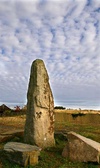
Stone of Morphie: This standing stone (measuring 1m by 0.7m at the base and 3.4m in height) is immediately S of the public road in the stackyard of Stone of Morphie farm. Traditionally said (New Statistical Account [NSA] 1845) to mark the grave of a son of Camus, killed in a battle between the Scots and the Danes, it was knocked down shortly before 1856. Digging prior to re-erection revealed part of a human skeleton, buried in black unctuous earth. The stone is freestone, and is uninscribed. as ref RCAHMS 1982; J Stuart 1856; Name Book 1863 More Information |
| Strichen Recumbent Stone Circle also known as Strichen House Stone Circle |

An atmospheric, restored, Buchan recumbent stone circle 13.5 meteres in diameter. The site has good views to the North-East of Mormond and Waughton Hill, and the White Horse, also overlooks the ruins of Strichen House. Currently (2005) a little overgrown with gorse More Information |
| Sunhoney Recumbent Stone Circle |

The monument is very well preserved recumbent stone circle, 25m - 26.7 in diameter, lying in an area bounded by a 19th-century plantation wall. The circle comprises 11 standing stones and the recumbent. The recumbent and one of the uprights bear cupmarks. Within the circle is a raised platform measuring some 7m across, probably the remains of a ring cairn. The circle is on a hilltop surrounded by trees above Sunhoney farm. |
T
| The Gouk Stone, Bennachie |
|---|

The Goukstane ("Cuckoo stone"), which is signposted just off the walk to the summit. Is a large boulder. According to legend it is said to be visited by the first cuckoo to return to Bennachie after spending winter in Africa. Other people believe that this large stone was thrown down the hill by the mythical giant Jock O' Bennachie. |
| Tomnaverie (Tarland) Stone Circle |

The recumbent stone circle is a form unique to North East Scotland. |
This content was submitted by external contributors and does not necessarily reflect the views of the University of Aberdeen.
